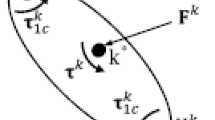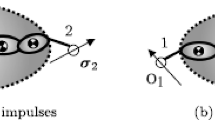Abstract
A new algorithm, Orthogonal Complement based Divide-and-Conquer Algorithm (O-DCA), is presented in this paper for calculating the forward dynamics of constrained multi-rigid bodies including topologies involving single or coupled closed kinematic loops. The algorithm is exact and noniterative. The constraints are imposed at the acceleration level by utilizing a kinematic relation between the joint motion subspace (or partial velocities) and its orthogonal complement. Sample test cases indicate excellent constraint satisfaction and robust handling of singular configurations. Since the present algorithm does not use either a reduction or augmentation approach in the traditional sense for imposing the constraints, it does not suffer from the associated problems for systems passing through singular configurations. The computational complexity of the algorithm is expected to be O(n+m) and O(log(n+m)) for serial and parallel implementation, respectively, where n is the number of generalized coordinates and m is the number of independent algebraic constraints.
Similar content being viewed by others
References
Hooker, W.W., Margulies, G.: The dynamical attitude equations for an n-body satellite. J. Astronaut. Sci. 7(4), 123–128 (1965)
Luh, J.S.Y., Walker, M.W., Paul, R.P.C.: On-line computational scheme for mechanical manipulators. J. Dynam. Syst. Meas. Control 102, 69–76 (1980)
Walker, M.W., Orin, D.E.: Efficient dynamic computer simulation of robotic mechanisms. J. Dynam. Syst. Meas. Control 104, 205–211 (1982)
Rosenthal, D.E., Sherman, M.A.: High performance multibody simulations via symbolic equation manipulation and Kane's method. J. Astronaut. Sci. 34(3), 223–239 (1986)
Neilan, P.E.: Efficient computer simulation of motions of multibody systems. PhD Thesis, Stanford University (1986)
Vereshchagin, A.F.: Computer simulation of the dynamics of complicated mechanisms of robot-manipulators. Eng. Cybernet. 12(6), 65–70 (1974)
Armstrong, W.W.: Recursive solution to the equations of motion of an n-link manipulator. In: Fifth World Congress on the Theory of Machines and Mechanisms, Vol. 2, Montreal, Canada, pp 1342–1346 (1979)
Featherstone, R.: The calculation of robotic dynamics using articulated body inertias. Int. J. Rob. Res. 2(1), 13–30 (1983)
Brandl, H., Johanni, R., Otter, M.: A very efficient algorithm for the simulation of robots and similar multibody systems without inversion of the mass matrix. In: IFAC/IFIP/IMACS Symposium, Vienna, Austria (1986)
Bae, D.S., Haug, E.J.: A recursive formation for constrained mechanical system dynamics: Part I, Open loop systems. Mech. Struct. Machines 15(3), 359–382 (1987)
Rosenthal, D.E.: An order n formulation for robotic systems. J. Astronaut. Sci. 38(4), 511–529 (1990)
Anderson, K.S.: Recursive derivation of explicit equations of motion for efficient dynamic/control simulation of large multibody systems. PhD Thesis, Stanford University, Stanford, CA(1990)
Kreutz-Delgado, K., Jain, A., Rodriguez, G.: Recursive formulation of operational space control. Int. J. Rob. Res. 11(4), 320–328 (1992)
Jain, A.: Unified formulation of dynamics for serial rigid multibody systems. J. Guid. Control Dynam. 14(3), 531–542 (1991)
Featherstone, R.: Robot Dynamics Algorithms. Kluwer Academic, New York (1987)
Bae, D.S., Haug, E.J.: A recursive formation for constrained mechanical system dynamics: Part II, Closed loop systems. Mech. Struct. Machines 15(4), 481–506 (1987)
Wehage, R.A.: Application of matrix partitioning and recursive projection to O(n) solution of constrained equations of motion. In: ASME Design Engineering Division, DE, Vol. 15-2, pp. 221–230 (1988)
Anderson, K.S., Critchley, J.H.: Improved order-n performance algorithm for the simulation of constrained multi-rigid-body systems. Multibody Syst. Dynam. 9, 185–212 (2003)
Critchley, J.H., Anderson, K.S.: A generalized recursive coordinate reduction method for multibody system dynamics. J. Multiscale Comput. Eng. 1(2 & 3), 181–200 (2003)
Lötstedt, P.: On a penalty function method for the simulation of mechanical systems subject to constraints. Report TRITA-NA-7919, Royal Institute of Technology, Stockholm, Sweden (1979)
Lötstedt, P.: Mechanical systems of rigid bodies subject to unilateral constraints. SIAM J. Appl. Math. 42(2), 281–296 (1982)
Baumgarte, J.: Stabilization of constraints and integrals of motion in dynamic systems. Comput. Method Appl. Mech. Eng. 1, 1–16 (1972)
Baumgarte, J.W.: A new method for stabilization of holonomic contraints. J. Appl. Mech. 50, 869–870 (1983)
Park, K.C., Chiou, J.C.: Stabilization of computational procedures for constrained dynamical systems. J. Guid. Control Dynam. 11(4), 365–370 (1988)
Bayo, E., Garcia de Jalon, J., Serna, M.A.: Modified Lagrangian formulation for the dynamic analysis of constrained mechanical systems. Comput. Methods Appl. Mech. Eng. 71(2), 183–195 (1988)
Anderson, K.S.: An order-n formulation for motion simulation of general constrained multi-rigid-body systems. Comput. Struct. 43(3), 565–572 (1992)
Stejskal, V., Valášek, M.: Kinematics and Dynamics of Machinery. Marcel Dekker, New York (1996)
Saha, S.K., Schiehlen, W.O.: Recursive kinematics and dynamics for parallel structured closed-loop multibody systems. Mech. Struct. Machines 29(2), 143–175 (2001)
Fijany, A., Sharf, I., D'Eleuterio, G.M.T.: Parallel O(log n) algorithms for computation of manipulator forward dynamics. IEEE Trans. Rob. Autom. 11(3), 389–400 (1995)
Featherstone, R.: A divide-and-conquer articulated body algorithm for parallel O(log(n)) calculation of rigid body dynamics. Part 1: Basic algorithm. Int. J. Rob. Res. 18(9), 867–875 (1999)
Featherstone, R.: A divide-and-conquer articulated body algorithm for parallel O(log(n)) calculation of rigid body dynamics. Part 2: Trees, loops, and accuracy. Int. J. Rob. Res. 18(9), 876–892 (1999)
Kim S.S., VanderPloeg M.J.: Generalized and efficient method for dynamic analysis of mechanical systems using velocity transforms. J. Mech. Trans. Autom. Des. 108(2), 1986, 176–182.
Nikravesh P.E.: Systematic reduction of multibody equations to a minimal set. Int. J. Non-Linear Mech. 25(2–3), 143–151 (1990)
Kane T.R., Levinson D.A.: Dynamics: Theory and Application. McGraw-Hill, New York (1985)
Author information
Authors and Affiliations
Corresponding author
Rights and permissions
About this article
Cite this article
Mukherjee, R.M., Anderson, K.S. Orthogonal Complement Based Divide-and-Conquer Algorithm for constrained multibody systems. Nonlinear Dyn 48, 199–215 (2007). https://doi.org/10.1007/s11071-006-9083-3
Received:
Accepted:
Published:
Issue Date:
DOI: https://doi.org/10.1007/s11071-006-9083-3




